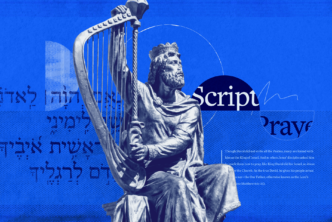Dirk Jongkind’s Introduction to the Greek New Testament Produced at Tyndale House, Cambridge is a short, simple, and excellent introduction to New Testament textual criticism. It has such a long title because it also tells a bit of the story behind the new Tyndale House Greek New Testament (THGNT), the goal of which is “to give the text of the original Greek as accurately as possible.” (Anyone interested in textual criticism or involved in academic biblical studies should have the new THGNT—and it happens to be on Pre-Pub in Logos right now.)
I’m going to summarize and review Jongkind’s brand new book mainly because I so appreciated the theological and practical insights it offered me personally.
Pastorally sensitive
Jongkind is an academic, but his evangelical and pastoral heart comes out several times in his book. He’s right, for example, when he observes that
for many readers of the New Testament, it is a disturbing moment when they are told that differences in the wording of the Greek text exist between the various handwritten copies of the text.
One way to quell this disturbing feeling in others is to explain some of the details of textual criticism. Jongkind’s book does this. He explains textual criticism at just about the most accessible level possible, given the topic’s inherent complexity. And yet twice, at least, he makes this profound point, which I think Christ’s sheep need to hear from their shepherds:
The main problem in understanding the New Testament is not any uncertainty about its precise wording but rather our inability to grasp and absorb the message in its full impact and complexity.
Because these are God’s words we’re talking about, nit-picking the details of scribal habits and geographical distribution of readings and the marking of initial, secondary, and tertiary hands that touched a text are all important. And Jongkind is a master of these details who has spent years immersed in them. This book will indeed help beginning students of NT textual criticism understand the discipline, but Dirk’s pastoral sensitivity and evangelical faith undercut the emotional angst of textual critical debate by making that point I just quoted.
I’ll get back to this point at the end of my brief review.
Now a rundown of the book’s contents.
Book summary
Chapter 1 starts by describing the difference between “translations,” “editions,” and “originals.” It gives the most basic practical description of how the THGNT came to be, namely with the digitization of Tregelles’ nineteenth-century work.
And Jongkind piqued my interest here because he promised,
Near the end of this book I hope to present the beginnings of a biblical-theological view of the transmission of the text.
Hmm! Appetite: whetted.
Chapter 2 provides basic practical instruction for using a critical edition of the Greek New Testament. Much of what he says applies to other editions, such as the Nestle-Aland or UBS. But he also explains unusual features of the THGNT: the order of the books, the “ekthetical” style of paragraphing, the unregularized spelling. I had previously thought the new edition was just trying to distinguish itself from other GNTs with these choices, but I learned there is some rhyme and reason behind these choices.
(Incidentally, I find it fascinating that, in Jongkind’s estimation, paragraphing hasn’t always meant what it means today. “In adopting such practices from old manuscripts, we should not assume that what we think of as a paragraph is the same as what the ancients did. Nowadays a paragraph is a building block in the hierarchical structure of the text. But in some of the manuscript paragraphing, one gets the impression that a paragraph is used to highlight what follows, as, for example, in Mark 2:10. And frankly, there are places where it is difficult to find any ‘system’ behind what is happening.” Language changes on multiple levels, beyond just the meanings of words.)
Chapter 3 discusses a number of specific New Testament manuscripts in nerdy detail. He makes a number of confident judgments, though standard ones, about the high or low quality of respective manuscripts. He does this without referencing discussions or giving reasons; this is a book for nerdy beginners.
Chapter 4 gets into the meaty issues of “how decisions are made” among New Testament manuscript variants. Jongkind posits four major areas used for the THGNT: 1) distribution of the evidence, 2) knowledge of the individual manuscripts, 3) knowledge of groupings of manuscripts, and 4) knowledge of scribal behavior. Point 4 is the leading point given out in other descriptions I’ve seen of the new GNT edition. In this chapter, Jongkind discusses the NT copying process and briefly covers a few important variants, such as the ending of Mark and the woman caught in adultery.
Chapters 5 and 6 argue briefly against defenses of the Textus Receptus and of the Byzantine text. He makes the same basic argument I’ve made, for what little that is worth. He says that neither of those two positions absolves its adherents from having to do textual criticism. The simplest reply to the TR-Only believer is, “Which TR?” And, likewise, though there are responsible scholars who hold a Byzantine position, it is also commonly said by its proponents to be distinct from an eclectic text view (such as Jongkind’s and my own) precisely in that it delivers a greater amount of certainty—fewer variants. Maybe it does deliver this. But then it is a difference in degree and not in kind from an eclectic view, something you don’t tend to hear from its proponents.
Chapter 7 is really the final chapter (chapter 8 is one page), and it’s where Jongkind’s most important promises for the book come true. He said he would provide “a biblical-theological view of the transmission of the text.” He does so negatively and positively.
A theology of textual variants
Negatively, he questions the idea that God is required to give us a perfectly preserved Greek New Testament, a manuscript tradition (or a pure line of manuscripts) with no variants.
Who does Jongkind have in mind here? Who is expecting that the Greek New Testament should come to us perfectly preserved? The most obvious answer is likely our brothers in the KJV-Only world.
Now listen to this quote Jongkind gives—from, to be clear, someone he disagrees with. Who do you think said this?
The only reason (I came to think) for God to inspire the Bible would be so that his people would have his actual words; but if he really wanted people to have his actual words, surely he would have miraculously preserved those words, just as he had miraculously inspired them in the first place.
This is an argument I see frequently among proponents of KJV-Onlyism. Surely, they say, inspiration demands preservation.
But it wasn’t a KJV-Only Christian who said this; it wasn’t even a believer. It was famous atheistic New Testament scholar Bart Ehrman. (He uses the point to conclude that the Bible is not inspired, because it is not perfectly preserved.) Ehrman and KJV-Onlyism are strange bedfellows . . . Perhaps both are wrong on this point? Jongkind says they are:
Anyone who is studying the original languages of the Bible or who thinks deeply about the meaning of the text will come again and again to the conclusion that God has not given us exhaustive knowledge. We have (more than) sufficient knowledge, but a vast number of things that we do not know remains. We would like to know more about the historical context of Scripture, about the exact grammatical function of certain constructions, and about the specific semantic quality of unusual expressions. To expect that God would allow these limits to exist in any area of studying Scripture but not in our knowledge of the original text seems inconsistent. God does not perform a special miracle to protect our collective reading and understanding of his Word from error, and likewise, he has not done so for the transmission of Scripture. There are limits to our knowledge.
I find this so helpful. Indeed, if I got to be king of the earth (or evangelical pope?) for a day and God gave me the choice between receiving a perfect Greek and Hebrew text or a perfect commentary on the ever-so-slightly imperfectly preserved text we currently have, I’d choose the latter with no hesitation.
Jongkind and I both believe that the Bible has been remarkably well preserved. Just not perfectly preserved. I’ve long wanted to say to defenders of the KJV (as if I haven’t already said enough, I admit), “What’s the point in perfectly preserving words we can’t understand?” Like the obscure musical (?) terms in the superscriptions in the Psalms, or like simple Selah—it occurs about 70 times in the Psalms and a few times in Habakkuk, and we have no idea what it means.
There are many things I’d like to know with greater certainty:
- Does our love for Christ constrain us, or his love for us?
- Do Genesis 1–11 indicate a young or old earth? (In other words, did animal death occur before the fall?)
- Who are the proper subjects for baptism?
- Can someone lose his or her salvation?
- Are the miraculous gifts evident in the early church still being given today?
- Are people elected to salvation and damnation before their births?
One could go on and on. And no Greek New Testament readings in existence definitively answer any of these questions—questions that roil Christian relationships and cause permanent (under the sun) splits among Christian bodies.
If I could get special revelation from God to tell me whether the star “came and stood” over baby Jesus or “came to rest” over him, then, sure, I’d like to know. But—as Jongkind argues—God simply hasn’t told us. It isn’t clear. We don’t know. And Jongkind shows how this fits with other limitations God has given us. Jongkind is not positing errors in Scripture; he’s pointing out minor limitations in our knowledge of what counts as Scripture.
Jongkind also makes a positive theological case for the goodness of variants—the first I’ve ever seen. He asks,
What can we learn about God and about Scripture, assuming that God allowed variation to happen? Is there a story to tell that points us to something good and is in line with what God is doing in our days?
And he answers:
The spread-out character of the church was not a development by accident; it was by design. There is something inherently good about the discontinuity between the Jerusalem temple and the spiritual temple that is the church. Yet it was a development that had a profound effect on the transmission of the written Word—no longer was there a central authority that could authenticate the approved status of individual copies of the text, just as there was no single, central location that would produce approved copies. The absence of a central sanctuary in the worldwide apostolic church is intentional and theologically meaningful.
Wow. So there might be a good reason, in the plan of God, for these variants . . . Or at least they might be the fruit of something good. Even the Hebrew Bible has its Kethiv-Qere readings (a kind of textual apparatus), but the existence of a universally recognized central authority in Judaism meant that there was a high court of appeal for variants. There is no such thing in the Christian Church. And that’s not bad; it’s good. It’s a fruit of God’s intention, voiced to Abraham all those centuries ago, to bless all the families of the earth.
Including mine. And one of God’s blessings to me was Jongkind’s insights in this little book. I have and use my THGNT, and I’m looking forward to having it in Logos.






